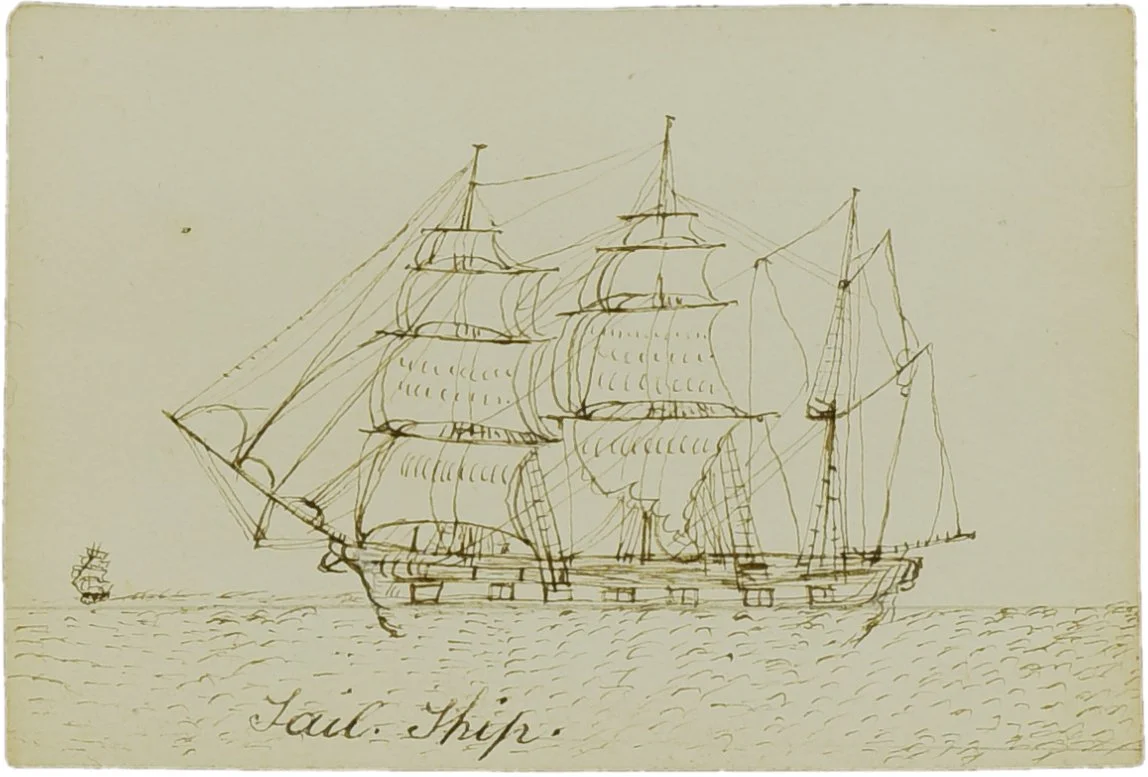Qalaherriaq [Erasmus Augustine Kallihirua]. Sail. Ship. 1853. Pen on paper. 7.6 x 11.6 cm. Derbyshire Record Office. D8760/F/OBJ/5. Reproduced courtesy of the Derbyshire Record Office
Sail. Ship is one of three drawings Qalaherriaq created for Mrs Eleanor Gell, the daughter of John Franklin, whose expedition went missing in the late 1840s. Presenting the side of a large, three-masted sailing vessel, Sail. Ship is reminiscent of British nineteenth-century ship portraits. A motif Qalaherriaq frequently drew, the ship was also what brought him away from his Inughuit community and into British society, first in the North American Arctic, then England and finally in Newfoundland.
Qalaherriaq lived most of his life as a hunter in Kalaallit Nunaat. After the death of his father in the winter of 1849/50, Qalaherriaq became the main provider for his mother and two siblings in this rich and giving, but challenging homeland. A more profound change to his life soon followed. In August 1850, British ships searching for Franklin landed in Perlernerit (Cape York) where they met with the Inughuit. Having heard rumours that the Inughuit had killed Franklin’s men, the search party demanded that Qalaherriaq take them to the site of the alleged murder. This place, further north along the coast, was in fact where Qalaherriaq’s people had met James Saunder’s crew of the HMS North Star the previous winter. This meeting had proved fatal to several of the Inguhuit, who were inflicted by a European disease (likely influenza) that came with the explorers.
After leading Ommanney’s expedition to this site – which turned out to be the gravestones to a couple of Saunder’s men and the graves of the Inughuit (including Qalaherriaq’s father) – Qalaherriaq was not returned to his home as originally agreed. Instead, he spent the following year onboard Ommanney’s vessel, before being taken to England, where he was enrolled at St Augustine’s Missionary College by the Lords of the Admiralty. Here he received religious training, learned to read and write English, and spent much time doing carpentry, tailoring and drawing. In the autumn of 1855, he was sent onwards to Newfoundland for further religious training at the College of the Theological Institution in St John’s, with the intention that he would later work among ‘heathen’ Inuit in Labrador, then a British colony. Since his departure from Kalaallit Nunaat, however, Qalaherriaq had suffered from chest pains and heavy colds. On 14 June 1856, he died from lung tuberculosis.
Unlike the dominant narratives of empire in which he features as a relative success story of the colonial mission, Inughuit oral history documents Qalaherriaq’s disappearance as a case of abduction that deeply traumatised his mother. Although his people never learned about what happened to him, they correctly assumed that the young hunter ‘quickly found his death among the white men’. In the early twentieth century, the Danish-Inuit explorer Knud Rasmussen recorded the story and later published it in his book, Foran Dagens Øje: Liv i Grønland (1915).
Essay by Ingeborg Høvik and Axl Ingemann-Jeremiassen
